Comparison of Performance between Genetic Algorithm and SCE-UA for Calibration of SCS-CN Surface Runoff Simulation
Abstract
:1. Introduction
| Case Study | GA | SCE-UA |
|---|---|---|
| Automatic calibration | 9 [18,19,20,21,22,23,24,25,26] | 19 [40,41,42,43,44,45,46,47,48,49,50,51,52,53,54,55,56,57,58] |
| Decision making | 11 [27,28,29,30,31,32,33,34,35,36,37] | 2 [59,60] |
| Algorithm enhancement | 2 [38,39] | 3 [61,62,63] |
2. Theoretical Background
2.1. Genetic Algorithm (GA)
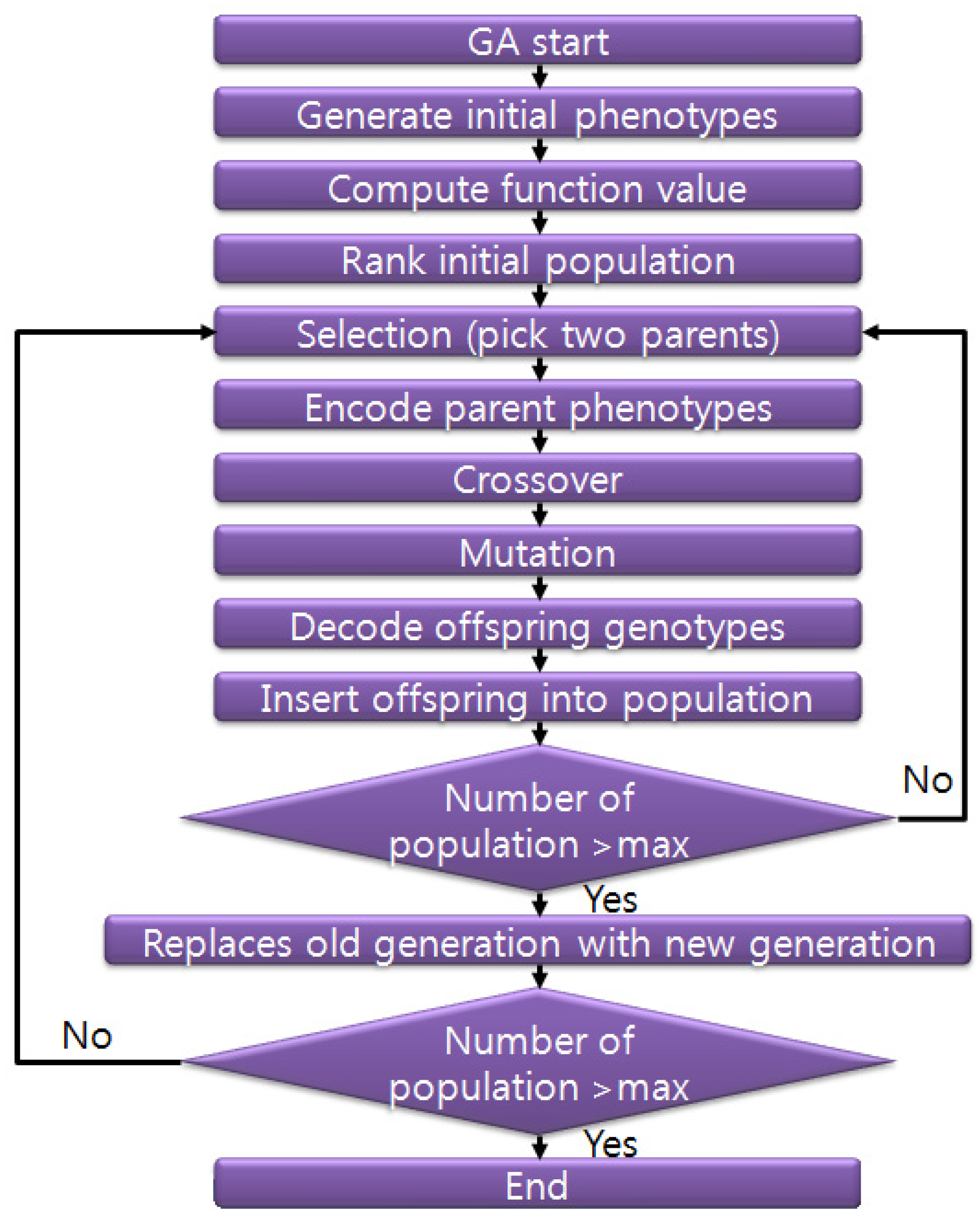

2.2. Shuffled Complex Evolution (SCE-UA)
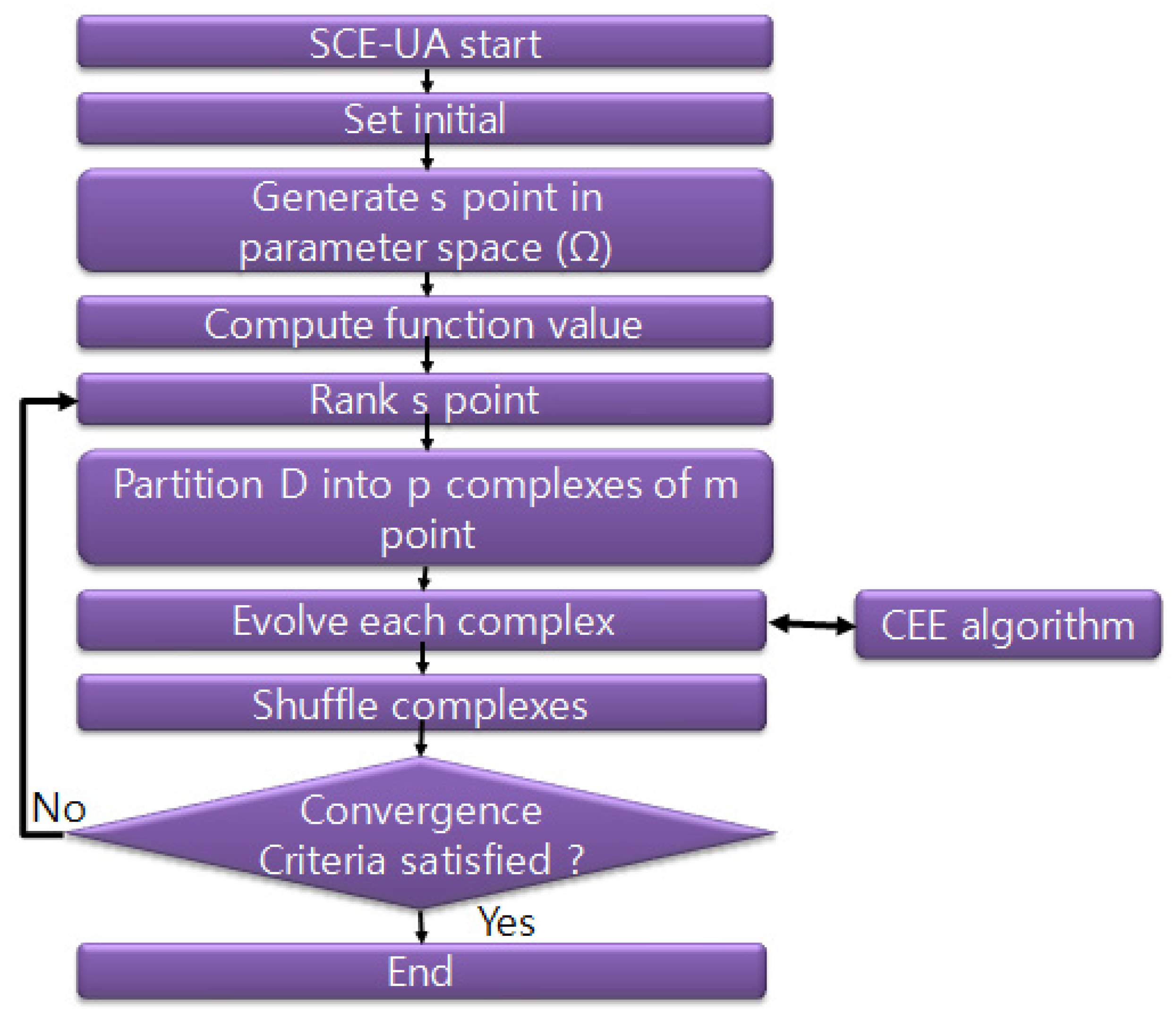
2.3. Long-Term Hydrologic Impact Assessment Model (L-THIA)
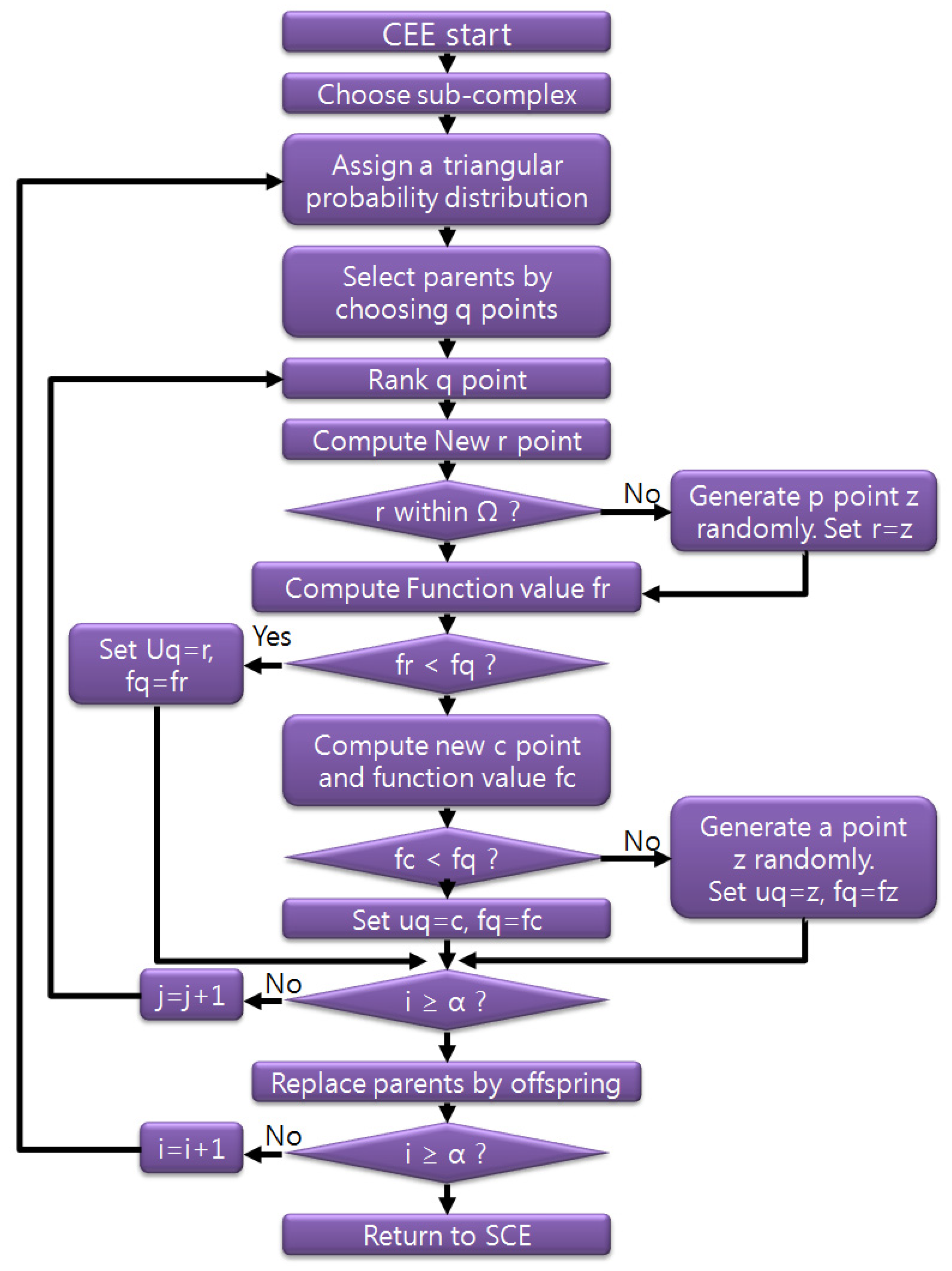
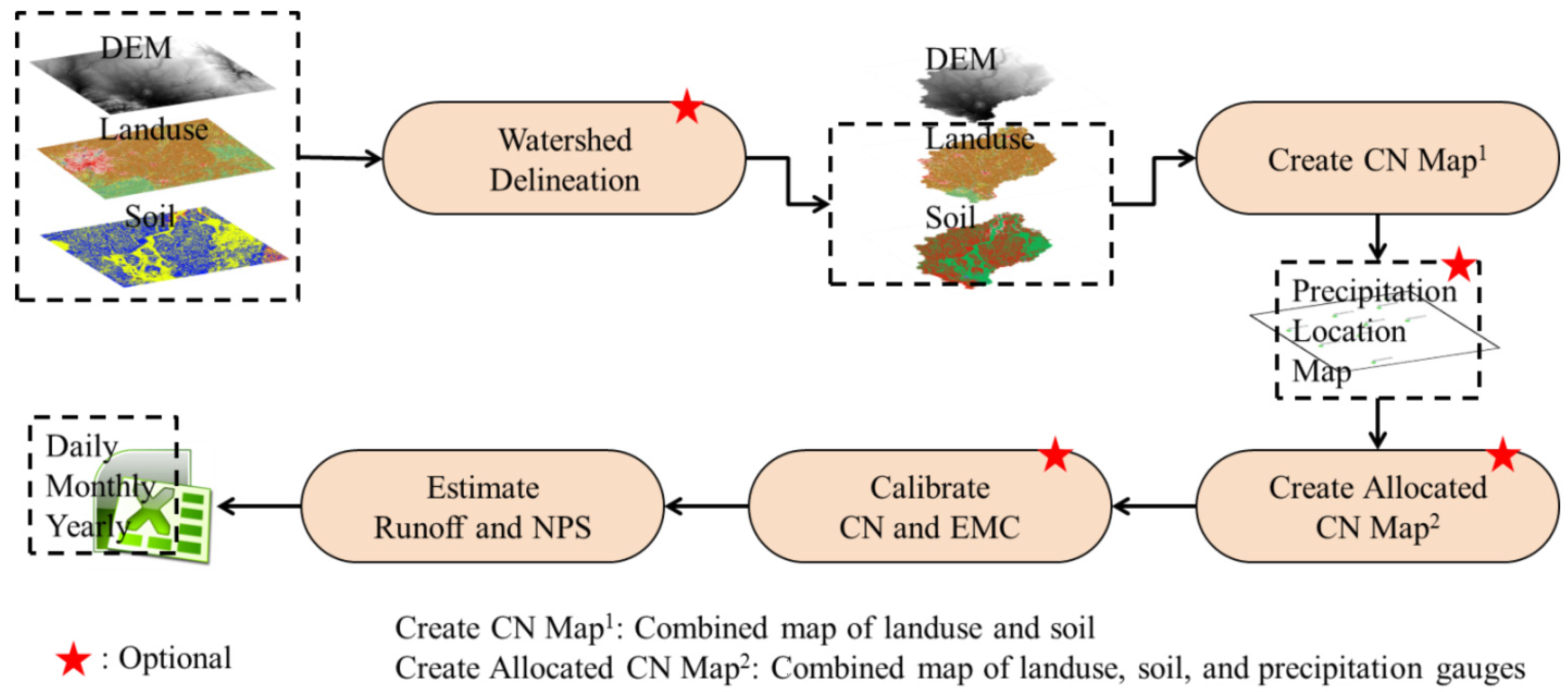
3. Materials and Methods
3.1. Modeling Approach
3.2. Optimization Approach
| AMC Condition | Amount of Total 5-Day Antecedent Rainfall (mm) | |
|---|---|---|
| Dormant Season | Growing Season | |
| AMC I | Less than 12.70 | Less than 35.56 |
| AMC II | 12.70–27.94 | 35.56–53.34 |
| AMC III | Over 27.94 | Over 53.34 |
| Land Use Type | Hydrologic Soil Group | Multiple Factor | |||
|---|---|---|---|---|---|
| A | B | C | D | ||
| Commercial/Industrial | 89 | 92 | 94 | 95 | PI |
| Crop land | 65 | 75 | 82 | 85 | PC |
| HD residential * | 77 | 85 | 90 | 92 | PH |
| LD residential ** | 54 | 70 | 80 | 85 | PL |
| Grasses and pasture | 39 | 61 | 74 | 80 | PG |
| Forest | 30 | 55 | 70 | 77 | PF |
3.3. Study Area and Data Preparation
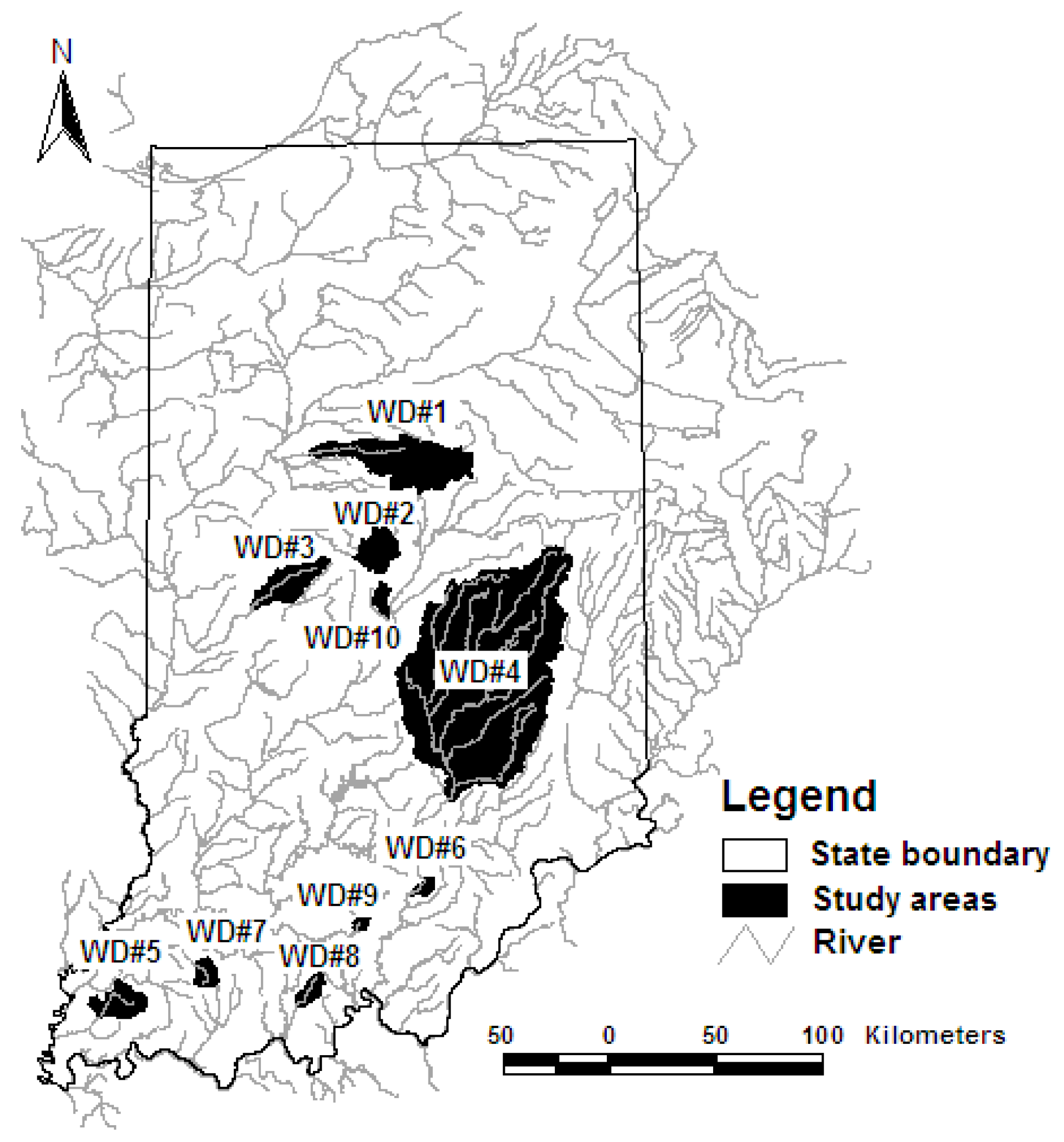
| WD# | Name | Area (km2) | Land Use (%) * | Hydrologic Soil Group (%) ** | Rainfall Station (COOPID) | USGS Station |
|---|---|---|---|---|---|---|
| 1 | Wildcat Creek | 1024.3 | I: 1, H: 1, L: 4, O: 7, C: 80, P: 2, F: 5 W:1 | A: 1, B: 52, C: 47, D: 1 | 122638, 122931, 124662, 124667, 128784, 129905 | 03334000 |
| 2 | Eagle Creek | 268.8 | I: 0, H: 0, L: 2, O: 8, C: 73, P: 10, F: 6, W:1 | A: 0, B: 50, C: 46, D: 3 | 129557 | 03353200 |
| 3 | Big Raccoon Creek | 364.7 | I: 0, H: 0, L: 1, O: 5 C: 83, P: 5 F: 7, W: 0 | A: 0, B: 49, C: 51, D: 1 | 121873 | 03340800 |
| 4 | East Fort White River | 5844.1 | I: 0, H: 1, L: 2, O: 6, C: 72, P: 5 F: 13, W:1 | A: 0, B: 51, C: 47, D: 2 | 121326, 121747, 123527, 123547, 124272, 124642 | 03365500 |
| 5 | Big Creek | 269.4 | I: 0, H: 0, L: 1, O: 7, C: 81, P: 1, F: 9, W: 0 | A: 0, B: 54, C: 45 D: 1 | 127083 | 03378550 |
| 6 | West Fork Blue River | 55.7 | I: 1, H: 0, L: 3, O: 0, C: 53, P: 0, F: 8, W: 0 | A: 0, B: 91, C: 9, D: 0 | 127755 | 03302680 |
| 7 | South Fork Patoka River | 110.7 | I: 0, H: 0, L: 0, O: 3, C: 21, P: 6, F: 66, W:3 | A: 0, B: 38,C: 57, D: 5 | 128442 | 03376350 |
| 8 | Middle Fork Anderson | 102.8 | I: 0, H: 0, L: 0, O: 4, C: 6, P: 17, F: 71, W:1 | A: 0, B: 61,C: 36, D: 3 | 127724 | 03303300 |
| 9 | Patoka River | 32.7 | I: 0, H: 0, L: 0, O: 3, C: 21, P: 6, F: 66, W:3 | A: 0, B: 38,C: 57, D: 5 | 126705 | 03374455 |
| 10 | Little Eagle Creek | 70.1 | I: 10, H: 20, L: 38, O: 27, C: 0, P: 0, F: 4, W:1 | A: 0, B: 33,C: 39, D: 28 | 124249 | 03353600 |
4. Results
4.1. Generated Individual between GA and SCE-UA
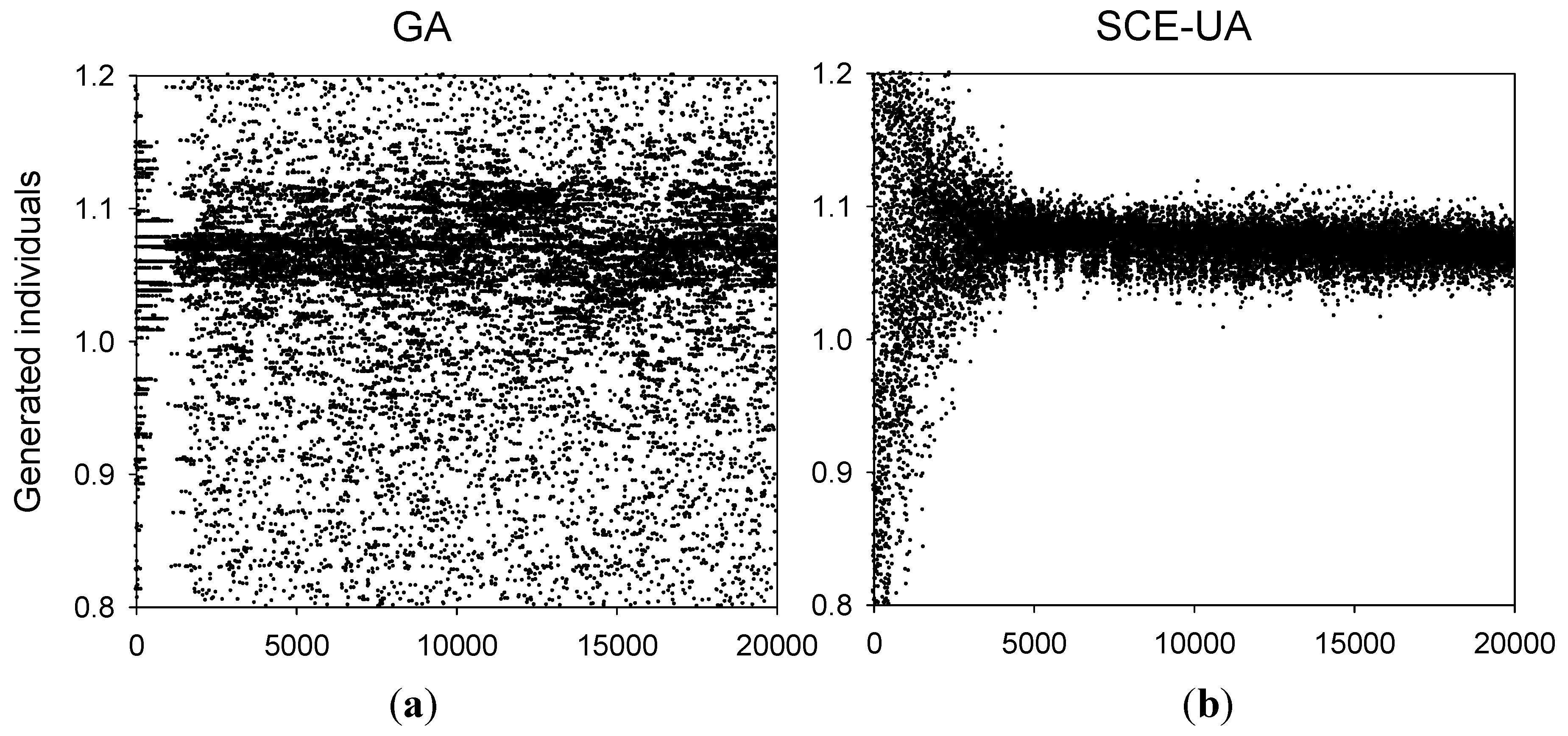
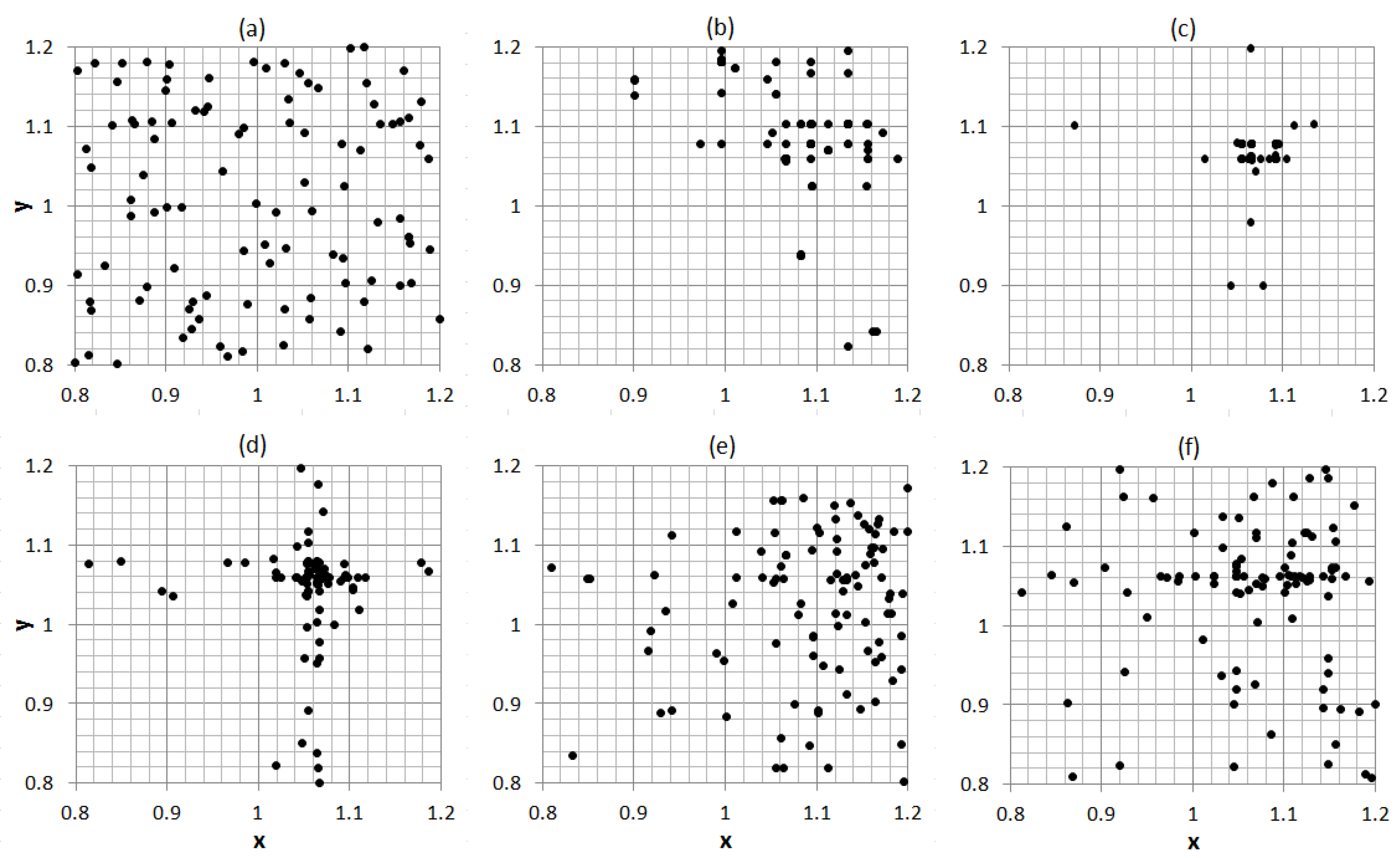
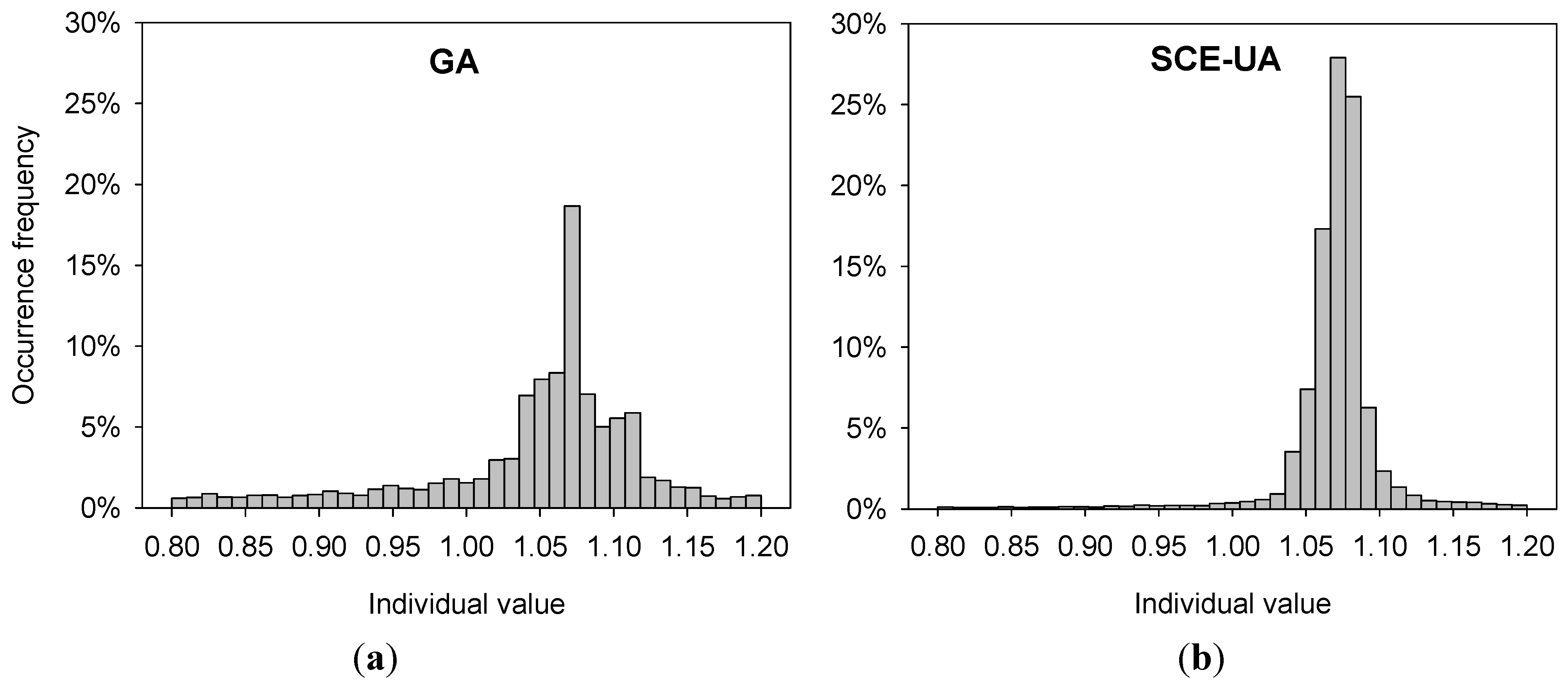
4.2. Performance of GA and SCE-UA for Model Calibration

| WD# | Calibration | ||||
|---|---|---|---|---|---|
| Period (year) | 5150 Model Runs | 20,000 Model Runs | |||
| GA | SCE-UA | GA | SCE-UA | ||
| l | 10 | 0.814 | 0.812 | 0.819 | 0.820 |
| 2 | 10 | 0.760 | 0.760 | 0.762 | 0.764 |
| 3 | 10 | 0.710 | 0.710 | 0.716 | 0.717 |
| 4 | 10 | 0.710 | 0.710 | 0.716 | 0.717 |
| 5 | 10 | 0.743 | 0.735 | 0.747 | 0.741 |
| 6 | 10 | 0.654 | 0.639 | 0.663 | 0.669 |
| 7 | 6 | 0.674 | 0.663 | 0.679 | 0.675 |
| 8 | 10 | 0.553 | 0.549 | 0.555 | 0.554 |
| 9 | 10 | 0.519 | 0.517 | 0.531 | 0.531 |
| 10 | 10 | 0.780 | 0.780 | 0.787 | 0.794 |
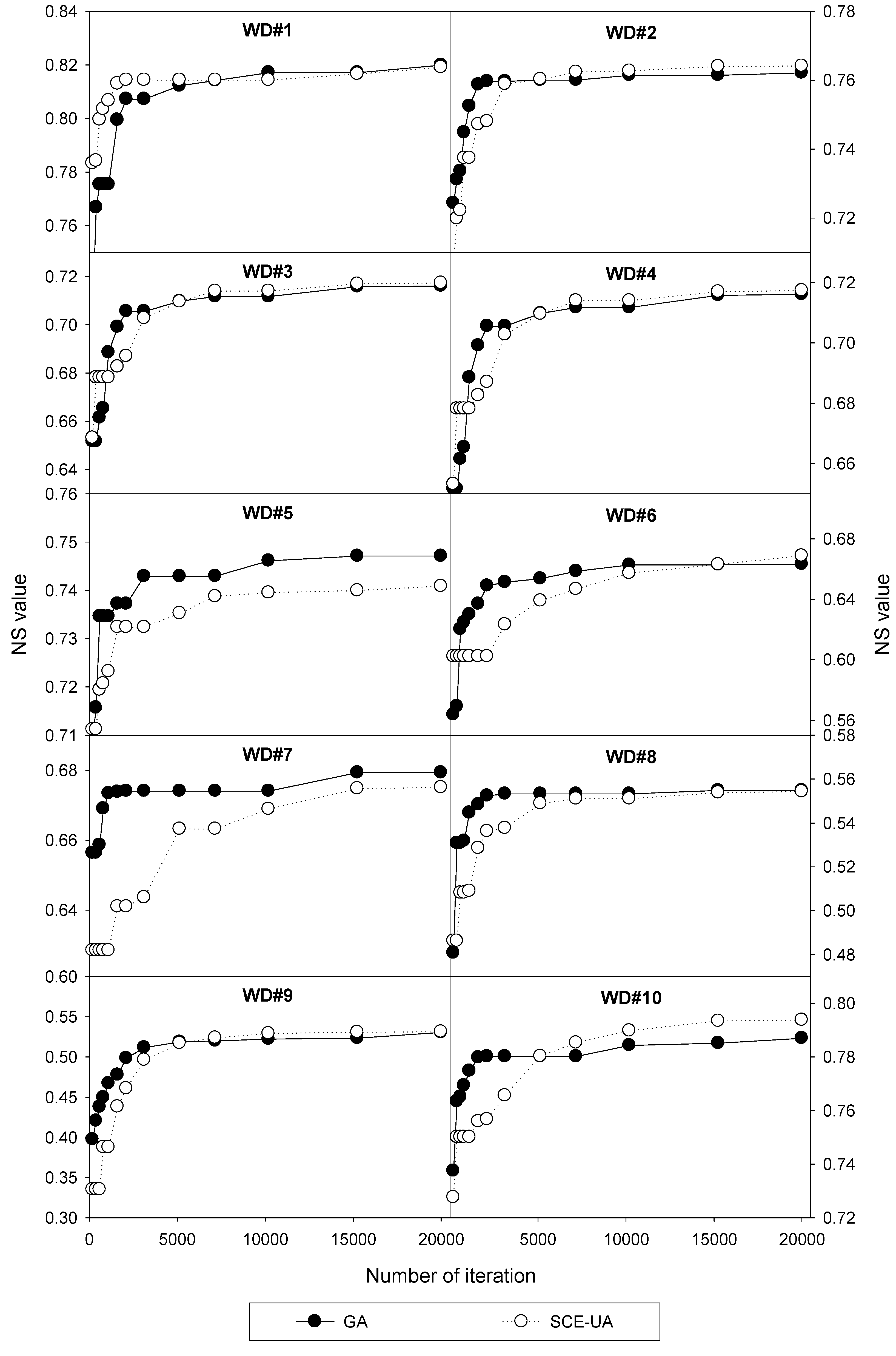

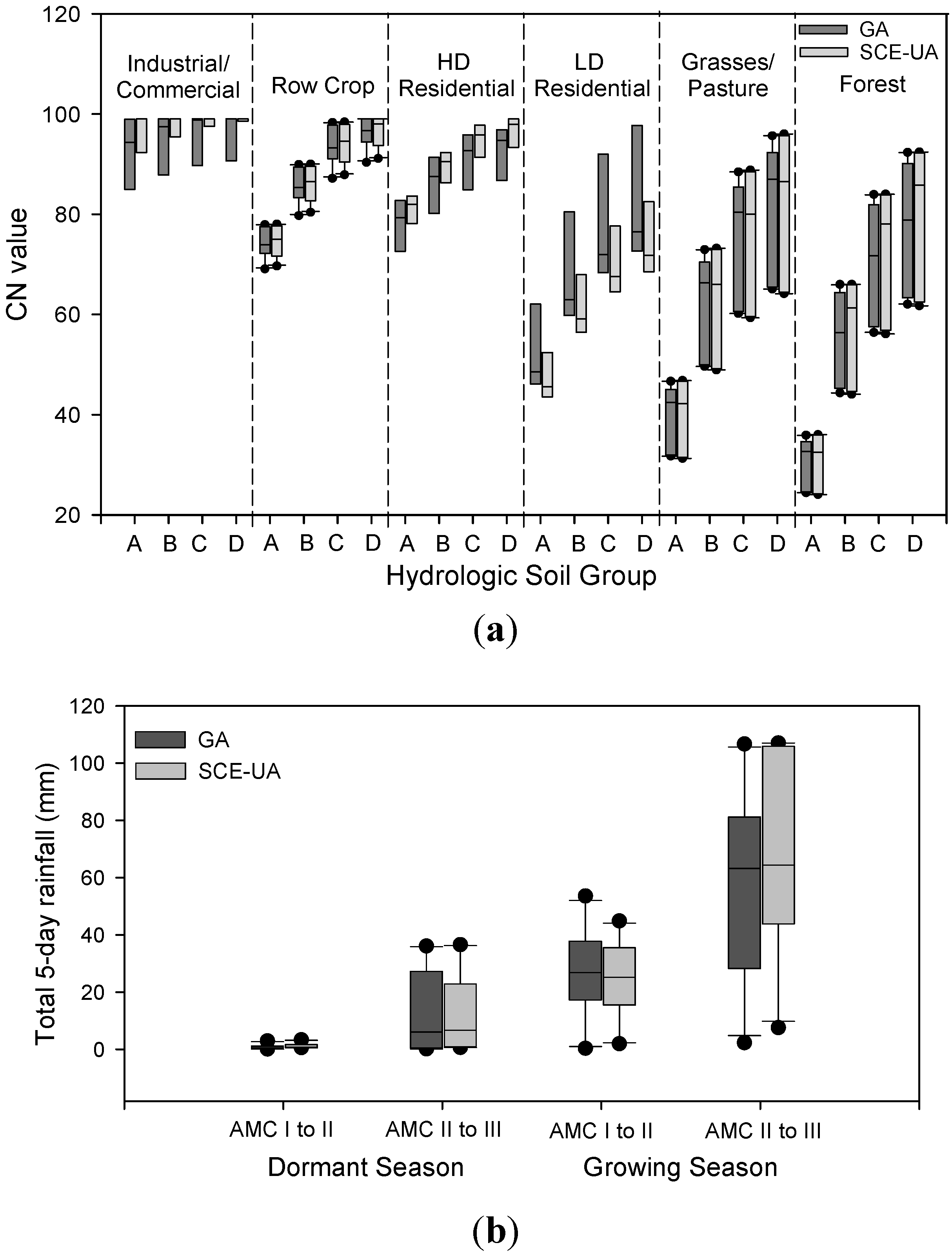
5. Discussion
6. Conclusions
Author Contributions
Conflicts of Interest
References
- Holland, J.H. Adaptation in Natural and Artificial System; University of Michigan Press: Ann Arbor, MI, USA, 1975. [Google Scholar]
- Duan, Q.; Sorooshian, S.; Gupta, V.K. Effective and efficient global optimization for conceptual rainfall-runoff models. Water Resour. Res. 1992, 28, 1015–1031. [Google Scholar] [CrossRef]
- Nelder, J.A.; Mead, R. A simplex method for function minimization. Comput. J. 1965, 7, 308–313. [Google Scholar] [CrossRef]
- Hooke, R.; Jeeves, T.A. Direct search solutions of numerical and statistical problems. J. ACM 1961, 8, 212–229. [Google Scholar] [CrossRef]
- Rosenbrock, H.H. An automatic method for finding the greatest or least value of a function. Comput. J. 1960, 3, 175–184. [Google Scholar] [CrossRef]
- Cooper, V.A.; Nguyen, V.T.V.; Nicell, J.A. Evaluation of global optimization methods for conceptual rainfall-runoff model calibration. Water Sci. Technol. 1997, 36, 53–60. [Google Scholar] [CrossRef]
- Duan, Q.; Gupta, V.K.; Sorooshian, S. A shuffled complex evolution approach for effective and efficient global minimization. J. Optimiz. Theory Appl. 1993, 76, 501–521. [Google Scholar] [CrossRef]
- Franchini, M.; Galeati, G.; Berra, S. Global optimization techniques for the calibration of conceptual rainfall-runoff models. Hydrol. Sci. J. 1998, 43, 443–458. [Google Scholar] [CrossRef]
- Gan, T.Y.; Biftu, G.F. Automatic calibration of conceptual rainfall-runoff model: Optimization algorithms, catchment conditions and model structure. Water Resour. Res. 1996, 32, 3513–3524. [Google Scholar] [CrossRef]
- Thyer, M.; Kuczera, G.; Bates, B.C. Probabilistic optimization for conceptual rainfall-runoff models: a comparison of the shuffled complex evolution and simulated annealing algorithms. Water Resour. Res. 1999, 35, 767–773. [Google Scholar] [CrossRef]
- Kuczera, G. Efficient subspace probabilistic parameter optimization for catchment models. Water Resour. Res. 1997, 33, 177–185. [Google Scholar] [CrossRef]
- Vasques, J.A.; Mailer, H.R.; Lence, B.J.; Tolson, B.A.; Foschi, R.O. Achieving water quality system reliability using genetic algorithms. J. Environ. Eng. 2000, 126, 954–962. [Google Scholar] [CrossRef]
- Ngo, L.L.; Madsen, H.; Rosbjerg, D. Simulation and optimization modelling approach for operation of the Hoa Binh reservoir, Vietnam. J. Hydrol. 2007, 336, 269–281. [Google Scholar] [CrossRef]
- Kerachian, R.; Karamouz, M. A stochastic conflict resolution model for water quality management in reservoir-river systems. Adv. Water Resour. 2007, 30, 866–882. [Google Scholar] [CrossRef]
- Park, S.Y.; Choi, J.H.; Wang, S.; Park, S.S. Design of a water quality monitoring network in a large river system using the genetic algorithm. Ecol. Model. 2006, 199, 289–297. [Google Scholar] [CrossRef]
- Arsenault, R.; Poulin, A.; Côté, P.; Brissette, F. A comparison of stochastic optimization algorithms in hydrological model calibration. J. Hydrol. Eng. 2013, 19, 1374–1384. [Google Scholar] [CrossRef]
- Tolson, B.A.; Shoemaker, C.A. Dynamically dimensioned search algorithm for computationally efficient watershed model calibration. Water Resour. Res. 2007, 43. [Google Scholar] [CrossRef]
- Dumedah, G.; Berg, A.A.; Wineberg, M.; Collier, R. Selecting model parameter sets from a trade-off surface generated from the non-dominated sorting genetic algorithm-II. Water Resour. Manag. 2010, 24, 4469–4489. [Google Scholar] [CrossRef]
- Wang, W.C.; Cheng, C.T.; Chau, K.W.; Xu, D.M. Calibration of Xinanjiang model parameters using hybrid genetic algorithm based fuzzy optimal model. J. Hydroinform. 2012, 14, 784–799. [Google Scholar] [CrossRef]
- Wu, S.J.; Lien, H.C.; Chang, C.H. Calibration of a conceptual rainfall-runoff model using a genetic algorithm integrated with runoff estimation sensitivity to parameters. J. Hydroinform. 2012, 14, 497–511. [Google Scholar] [CrossRef]
- Zhang, X.; Srinivasan, R.; Liew, M.V. On the use of multi-algorithm, genetically adaptive multi-objective method for multi-site calibration of the SWAT model. Hydrol. Process. 2010, 24, 955–969. [Google Scholar] [CrossRef]
- Zhang, X.; Srinivasan, R.; Arnold, J.; CesarIzaurralde, R.; Bosch, D. Simultaneous calibration of surface flow and base flow simulations: A revisit of the SWAT model calibration framework. Hydrol. Process. 2011, 25, 2313–2320. [Google Scholar] [CrossRef]
- Haddadchi, A.; Ryder, D.S.; Evrard, O.; Olley, J. Sediment fingerprinting in fluvial systems: Review of tracers, sediment sources and mixing models. Int. J. Sediment Res. 2013, 28, 560–578. [Google Scholar] [CrossRef]
- Rahman, K.; Maringanti, C.; Beniston, M.; Widmer, F.; Abbaspour, K.; Lehmann, A. Streamflow modeling in a highly managed mountainous glacier watershed using SWAT: The Upper Rhone River watershed case in Switzerland. Water Resour. Manag. 2013, 27, 323–339. [Google Scholar] [CrossRef]
- Lim, K.J.; Park, Y.S.; Kim, J.; Shin, Y.C.; Kim, N.W.; Kim, S.J.; Jeon, J.-H.; Engel, B.A. Development of genetic algorithm-based optimization module in WHAT system for hydrograph analysis and model application. Comput. Geosci. 2010, 36, 936–944. [Google Scholar] [CrossRef]
- Barnhart, B.; Whittaker, G.; Ficklin, D. Improved stream temperature simulation in SWAT using NSGA-II for automatic multi-site calibration. Transactions 2014, 52, 517–530. [Google Scholar]
- Kaini, P.; Artita, K.; Nicklow, J.W. Optimizing structural best management practices using SWAT and genetic algorithm to improve water quality goals. Water Resour. Manag. 2012, 26, 1827–1845. [Google Scholar] [CrossRef]
- Ahmadi, M.; Arabi, M.; Hoag, D.L.; Engel, B.A. A mixed discrete‐continuous variable multiobjective genetic algorithm for targeted implementation of nonpoint source pollution control practices. Water Resour. Manag. 2013, 49, 8344–8356. [Google Scholar] [CrossRef]
- Cao, K.; Huang, B.; Wang, S.; Lin, H. Sustainable land use optimization using Boundary-based Fast Genetic Algorithm. Comput. Environ. Urban 2012, 36, 257–269. [Google Scholar] [CrossRef]
- Rodriguez, H.G.; Popp, J.; Maringanti, C.; Chaubey, I. Selection and placement of best management practices used to reduce water quality degradation in Lincoln Lake watershed. Water Resour. Res. 2011, 47. [Google Scholar] [CrossRef]
- Limbrunner, J.F.; Vogel, R.M.; Chapra, S.C.; Kirshen, P.H. Classic optimization techniques applied to stormwater and nonpoint source pollution management at the watershed scale. J. Water Res. Plan. Manag. 2013, 139, 486–491. [Google Scholar] [CrossRef]
- Lee, J.G.; Selvakumar, A.; Alvi, K.; Riverson, J.; Zhen, J.X.; Shoemaker, L.; Lai, F.H. A watershed-scale design optimization model for stormwater best management practices. Environ. Model. Softw. 2012, 37, 6–18. [Google Scholar] [CrossRef]
- Chichakly, K.J.; Bowden, W.B.; Eppstein, M.J. Minimization of cost, sediment load, and sensitivity to climate change in a watershed management application. Environ. Model. Softw. 2013, 50, 158–168. [Google Scholar] [CrossRef]
- Artita, K.S.; Kaini, P.; Nicklow, J.W. Examining the possibilities: Generating alternative watershed-scale BMP designs with evolutionary algorithms. Water Resour. Manag. 2013, 27, 3849–3863. [Google Scholar] [CrossRef]
- Babbar-Sebens, M.; Barr, R.C.; Tedesco, L.P.; Anderson, M. Spatial identification and optimization of upland wetlands in agricultural watersheds. Ecol. Eng. 2013, 52, 130–142. [Google Scholar] [CrossRef]
- Hakimi-Asiabar, M.; Ghodsypour, S.H.; Kerachian, R. Deriving operating policies for multi-objective reservoir systems: Application of self-learning genetic algorithm. Appl. Soft Comput. 2010, 10, 1151–1163. [Google Scholar] [CrossRef]
- Yazdi, J.; Salehi Neyshabouri, S.A.A.; Niksokhan, M.H.; Sheshangosht, S.; Elmi, M. Optimal prioritisation of watershed management measures for flood risk mitigation on a watershed scale. J. Flood Risk Manag. 2013, 6, 372–384. [Google Scholar] [CrossRef]
- Chen, L.; Kao, S.J.; Traore, S. Predicting and managing reservoir total phosphorus by using modified grammatical evolution coupled with a macro-genetic algorithm. Environ. Model. Softw. 2012, 38, 89–100. [Google Scholar] [CrossRef]
- Chenari, K.S.; Ghaderi, M.; Reza, K.M. Improved adaptive genetic algorithm and its application in short-term optimal operation of water resources system. Res. J. Agric. Environ. Manag. 2014, 3, 209–217. [Google Scholar]
- Beskowa, S.; Melloc, C.R.; Nortond, L.D.; da Silvac, A.M. Performance of a distributed semi-conceptual hydrological model under tropical watershed conditions. CATENA 2011, 86, 160–171. [Google Scholar] [CrossRef]
- Khakbaz, B.; Imam, B.; Hsu, K.; Sorooshian, S. From lumped to distributed via semi-distributed: Calibration strategies for semi-distributed hydrologic models. J. Hydrol. 2012, 418, 61–77. [Google Scholar] [CrossRef]
- Chen, J.; Brissette, F.P.; Poulin, A.; Leconte, R. Overall uncertainty study of the hydrological impacts of climate change for a Canadian watershed. Water Resour. Res. 2011, 47. [Google Scholar] [CrossRef]
- Lei, X.; Tian, Y.; Liao, W.; Bai, W.; Jia, Y.W.; Jiang, Y.Z.; Wang, H. Development of an AutoWEP distributed hydrological model and its application to the upstream catchment of the Miyun Reservoir. Comput. Geosci. 2012, 44, 203–213. [Google Scholar] [CrossRef]
- Shi, P.; Hou, Y.; Xie, Y.; Chen, C.; Chen, X.; Li, Q.; Qu, S.; Fang, X.; Srinivasan, R. Application of a SWAT model for hydrological modeling in the Xixian watershed, China. J. Hydrol. Eng. 2013, 18, 1522–1529. [Google Scholar] [CrossRef]
- Jeon, J.H.; Lim, K.J.; Engel, B.A. Regional calibration of SCS-CN L-THIA model: Application for ungauged basins. Water 2014, 6, 1339–1359. [Google Scholar] [CrossRef]
- Xu, H.; Chen, Y.; Zeng, B.; He, J.; Liao, Z. Application of SCE-UA algorithm to parameter optimization of Liuxihe model. Trop. Geogr. 2012, 1, 32–37. [Google Scholar]
- Song, X.M.; Zhan, C.S.; Xia, J. Integration of a statistical emulator approach with the SCE-UA method for parameter optimization of a hydrological model. Chin. Sci. Bull. 2012, 57, 3397–3403. [Google Scholar] [CrossRef]
- Wu, H.; Chen, B. Evaluating uncertainty estimates in distributed hydrological modeling for the Wenjing River watershed in China by GLUE, SUFI-2, and ParaSol methods. Ecol. Eng. 2014, in press. [Google Scholar]
- Rasolomanana, S.D.; Lessard, P.; Vanrolleghem, P.A. Single-objective vs. multi-objective autocalibration in modelling total suspended solids and phosphorus in a small agricultural watershed with SWAT. Water Sci. Technol. 2012, 65, 643–652. [Google Scholar] [CrossRef] [PubMed]
- Pradhanang, S.M.; Mukundan, R.; Schneiderman, E.M.; Zion, M.S.; Anandhi, A.; Pierson, D.C.; Frei, A.; Easton, Z.M.; Fuka, D.; Steenhuis, T.S. Streamflow responses to climate change: Analysis of hydrologic indicators in a New York City water supply watershed. J. Am. Water Resour. Assoc. 2013, 49, 1308–1326. [Google Scholar] [CrossRef]
- Poulin, A.; Brissette, F.; Leconte, R.; Arsenault, R.; Malo, J.S. Uncertainty of hydrological modelling in climate change impact studies in a Canadian, snow-dominated river basin. J. Hydrol. 2011, 409, 626–636. [Google Scholar] [CrossRef]
- Ricard, S.; Bourdillon, R.; Roussel, D.; Turcotte, R. Global calibration of distributed hydrological models for large-scale applications. J. Hydrol. Eng. 2012, 18, 719–721. [Google Scholar] [CrossRef]
- Liong, S.Y.; Raghavan, S.V.; Vu, M.T. Climate Change and Its Impacts on Streamflow: WRF and SCE-Optimized SWAT Models. In Data Assimilation for Atmospheric, Oceanic and Hydrologic Applications; Springer Berlin: Heidelberg, Germany, 2013; Volume II, pp. 411–428. [Google Scholar]
- Nasonova, O.N.; Gusev, E.M.; Kovalev, E.E. Application of a land surface model for simulating rainfall streamflow hydrograph: 1. Model calibration. Water Resour. 2011, 38, 155–168. [Google Scholar] [CrossRef]
- Casimiro, L.; Sven, W.; Labat, D.; Guyot, J.L.; Ardoin-Bardin, S. Assessment of climate change impacts on the hydrology of the Peruvian Amazon-Andes basin. Hydrol. Process. 2011, 25, 3721–3734. [Google Scholar] [CrossRef]
- Bao, H.J.; Wang, L.L.; Li, Z.J.; Zhao, L.N.; Zhang, G.P. Hydrological daily rainfall-runoff simulation with BTOPMC model and comparison with Xin’anjiang model. Water Sci. Eng. 2010, 3, 121–131. [Google Scholar]
- Kwon, H.; Grunwald, S.; Beck, H.; Jung, Y. Automatic calibration of a hydrologic model for simulating groundwater table fluctuations on farms in the everglades agricultural area of south Florida. Irrig. Drain. 2014, 63, 538–549. [Google Scholar] [CrossRef]
- Guo, J.; Zhou, J.; Zou, Q.; Liu, Y.; Song, L. A novel multi-objective shuffled complex differential evolution algorithm with application to hydrological model parameter optimization. Water Resour. Manag. 2013, 27, 2923–2946. [Google Scholar] [CrossRef]
- Kang, M.; Park, S. Modeling water flows in a serial irrigation reservoir system considering irrigation return flows and reservoir operations. Agric. Water Manag. 2014, 143, 131–141. [Google Scholar] [CrossRef]
- Dong, J.R.; Zheng, C.Y.; Kan, G.Y.; Zhao, M. Optimal scheduling of hydrothermal system with network and ramping via SCE-UA method. Open Cybern. Syst. J. 2013, 7, 55–64. [Google Scholar] [CrossRef]
- Kang, T.; Lee, S. Modification of the SCE-UA to include constraints by embedding an adaptive penalty function and application: Application approach. Water Resour. Manag. 2014, 28, 2145–2159. [Google Scholar] [CrossRef]
- Dakhlaoui, H.; Bargaoui, Z.; Bárdossy, A. Toward a more efficient calibration schema for HBV rainfall-runoff model. J. Hydrol. 2012, 444, 161–179. [Google Scholar] [CrossRef]
- Chu, W.; Gao, X.; Sorooshian, S. Improving the shuffled complex evolution scheme for optimization of complex nonlinear hydrological systems: Application to the calibration of the Sacramento soil‐moisture accounting model. Water Resour. Res. 2010, 46. [Google Scholar] [CrossRef]
- Agrawal, R.K.; Singh, J.K. Application of a genetic algorithm in the development and optimization of a non-linear dynamic runoff model. Biosyst. Eng. 2003, 86, 87–95. [Google Scholar] [CrossRef]
- Charbonneau, P.; Knapp, B. A User’s Guide to PIKAIA 1.0.; NCAR technical note NCAR/TN-418+IA; High Altitude Observatory National Center for Atmospheric Research: Boulder, CO, USA, 1995. [Google Scholar]
- Park, Y.S.; Lim, K.J.; Theller, L.; Engel, B.A. L-THIA GIS Manual (Long-Term Hydrologic Impact Assessment). 2013. Available online: https://engineering.purdue.edu/mapserve/LTHIA7/arclthia/LTHIA2013_Manual.pdf (accessed on 12 July 2014).
- L-THIA WEB. Available online: https://engineering.purdue.edu/~lthia/ (accessed on 12 July 2014).
- Grove, M.; Harbor, J.; Engel, B.A.; Muthukrishnan, S. Impact of urbanization on surface hydrology, Little Eagle Creek, Indiana, and analysis of L-THIA model sensitivity to data resolution. Phys. Geogr. 2001, 22, 135–153. [Google Scholar]
- Kim, Y.; Engel, B.A.; Lim, K.J.; Larson, V.; Duncan, B. Runoff impacts of land-use change in Indian river lagoon watershed. J. Hydrol. Eng. 2002, 7, 245–251. [Google Scholar] [CrossRef]
- Choi, J.Y.; Engel, B.A.; Muthukrishnan, S.; Harbor, J. GIS based long term hydrologic impact evaluation for watershed urbanization. J. Am. Water Resour. Assoc. 2003, 39, 623–635. [Google Scholar] [CrossRef]
- Gunn, R.; Martin, A.; Engel, B.; Ahiablame, L. Development of two indices for determining hydrologic implications of land use changes in urban areas. Urban Water J. 2012, 9, 239–248. [Google Scholar] [CrossRef]
- Bhaduri, B.; Harbor, J.; Engel, B.A.; Grove, M. Assessing watershed-scale, long-term hydrologic impacts of land use change using a GIS-NPS model. J. Environ. Manag. 2000, 26, 643–658. [Google Scholar] [CrossRef]
- Zhang, J.; Shen, T.; Liu, M.; Wan, Y.; Liu, J.; Li, J. Research on non-point source pollution spatial distribution of Qingdao based on L-THIA model. Math Comput. Model. 2011, 54, 1151–1159. [Google Scholar] [CrossRef]
- You, Y.Y.; Jin, W.B.; Xiong, Q.X.; Xue, L.; Ai, T.C.; Li, B.L. Simulation and validation of non-point source nitrogen and phosphorus loads under different land uses in Sihu Basin, Hubei Province, China. Proc. Environ. Sci. 2012, 13, 1781–1797. [Google Scholar] [CrossRef]
- Tang, Z.; Engel, B.A.; Pijanowski, B.C.; Lim, K.L. Forecasting land use change and its environmental impact at a watershed scale. J. Environ. Manag. 2005, 76, 35–45. [Google Scholar] [CrossRef]
- Tang, Z.; Engel, B.A.; Lim, K.J.; Pijanowski, B.C. Minimizing the impact of urbanization on long term runoff. J. Am. Water Resour. Assoc. 2005, 41, 1347–1359. [Google Scholar] [CrossRef]
- Choi, J.Y.; Engel, B.A.; Harbor, J. GIS and Web-Based DSS for Preliminary TMDL Development. In Total Maximum Daily Load (TMDL) Regulation; American Society of Agricultural and Biological Engineers: St. Joseph, MI, USA, 2002; pp. 477–484. [Google Scholar]
- Ahiablame, L.M.; Engel, B.A.; Chaubey, I. Representation and evaluation of low impact development practices with L-THIA-LID: An example for site planning. Environ. Pollut. 2012, 1, 1–13. [Google Scholar] [CrossRef]
- Hunter, J.G.; Engel, B.A.; Quansah, J.E. Web-Based Low Impact Development Decision Support Tool for Watershed Planning. In Proceedings of Low Impact Development, San Francisco, CA, USA, 11–14 April 2010; pp. 484–495.
- Ahiablame, L.M.; Engel, B.A.; Chaubey, I. Effectiveness of low impact development practices in two urbanized watersheds: Retrofitting with rain barrel/cistern and porous pavement. J. Environ. Manag. 2013, 119, 151–161. [Google Scholar] [CrossRef]
- Nash, J.E.; Sutcliffe, J.V. River flow forecasting through conceptual model. Part 1: A discussion of principles. J. Hydrol. 1970, 10, 282–290. [Google Scholar] [CrossRef]
- United States Department of Agriculture, Natural Resources Conservation Service (USDA-NRCS). Urban Hydrology for Small Watersheds; Technical Release 55 USDA-NRCS, 210-VI-TR-55; USDA-NRCS: Washington, DC, USA, 1986.
- Water: Science & Technology. Available online: http://www.epa.gov/waterscience/ftp/basins/gis_data/huc/ (accessed on 12 July 2014).
- Multi-Resolution Land Characteristics Consortium. Available online: http://www.mrlc.gov/index.asp/ (accessed on 12 July 2014).
- WHAT: Web-based Hydrograph Analysis Tool. Available online: https://engineering.purdue.edu/~what/ (accessed on 12 July 2014).
- National Climatic Data Center (NCDC). Available online: http://www.ncdc.noaa.gov/cdo-web/ (accessed on 12 July 2014).
- Wang, K.; Wang, N. A novel RNA genetic algorithm for parameter estimation of dynamic systems. Chem. Eng. Res. Des. 2010, 88, 1485–1493. [Google Scholar] [CrossRef]
- Coello, C.A.C.; van Veldhuizen, D.A.; Lamont, G.B. Evolutionary Algorithms for Solving Multi-Objective Problems; Kluwer Academic Publishers: New York, NY, USA, 2002. [Google Scholar]
- Deb, K.; Mohan, M.; Mishra, S. A Fast Multi-Objective Evolutionary Algorithm for Finding Well-Spread Pareto-Optimal Solutions; KanGAL Report No. 2003002; Indian Institute of Technology: Kanpur, India, 2003. [Google Scholar]
- Reed, P.; Minsker, B.S.; Goldberg, D.E. Simplifying multiobjective optimization: An automated design methodology for the nondominated sorted genetic algorithm-II. Water Resour. Res. 2003, 39. [Google Scholar] [CrossRef]
- Tang, Y.; Reed, P.; Wagener, T. How effective and efficient are multiobjective evolutionary algorithms at hydrologic model calibration? Hydrol. Earth Syst. Sci. 2006, 10, 289–307. [Google Scholar] [CrossRef]
- Gorgan, D.; Bacu, V.; Mihon, D.; Rodila, D.; Abbaspour, K.; Rouholahnejad, E. Grid based calibration of SWAT hydrological models. Nat. Hazard. Earth Syst. Sci. 2012, 12, 2411–2423. [Google Scholar] [CrossRef]
- Van Griensven, A.; Bauwens, W. Multiobjective autocalibration for semidistributed water quality models. Water Resour. Res. 2003, 39. [Google Scholar] [CrossRef]
- Willmott, C.J.; Robeson, S.M.; Matsuura, K. A refined index of model performance. Int. J. Climatol. 2012, 32, 2088–2094. [Google Scholar] [CrossRef]
© 2014 by the authors; licensee MDPI, Basel, Switzerland. This article is an open access article distributed under the terms and conditions of the Creative Commons Attribution license (http://creativecommons.org/licenses/by/4.0/).
Share and Cite
Jeon, J.-H.; Park, C.-G.; Engel, B.A. Comparison of Performance between Genetic Algorithm and SCE-UA for Calibration of SCS-CN Surface Runoff Simulation. Water 2014, 6, 3433-3456. https://doi.org/10.3390/w6113433
Jeon J-H, Park C-G, Engel BA. Comparison of Performance between Genetic Algorithm and SCE-UA for Calibration of SCS-CN Surface Runoff Simulation. Water. 2014; 6(11):3433-3456. https://doi.org/10.3390/w6113433
Chicago/Turabian StyleJeon, Ji-Hong, Chan-Gi Park, and Bernard A. Engel. 2014. "Comparison of Performance between Genetic Algorithm and SCE-UA for Calibration of SCS-CN Surface Runoff Simulation" Water 6, no. 11: 3433-3456. https://doi.org/10.3390/w6113433




